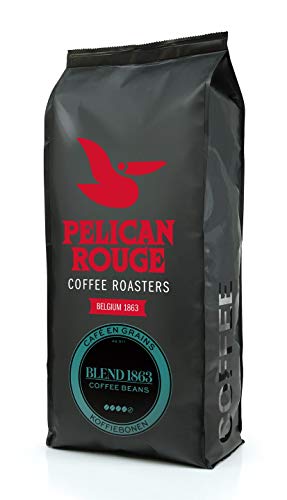Solutions To Problems With Types Of Coffee Beans
작성자 정보
- Cruz 작성
- 작성일
본문
Types of Coffee Beans
Behind every cup of coffee we sip there are carefully graded beans. The beans are evaluated in accordance with their size color, shape, and density.
The AA grade is given to coffee beans that fulfill the criteria mentioned above, with the exception that they must not contain more than three defects (quakers). They are typically Kenya AA beans.
Arabica
Arabica coffee beans are also known as Coffea Arabicica and are the most sought-after coffee bean coffee in the world. According to legend, coffee was discovered by a goatherder in Ethiopia after he noticed that his livestock had more energy when they consumed the fruits of the plant. This led him to experiment with roasting the seeds before brewing them, creating the drink which we enjoy today.
While many types of coffee plants exist however, there are two major species used to create the basis for all our favourite brews: arabica and robusta. The taste of the final drink is typically better when you drink the first.
There are many different arabica cultivars. Each one has its own unique taste profile. Typica and Bourbon are two of the most popular arabica cultivars. All other arabica cultivars were derived from these two varieties, either through natural mutations or 1Kg coffee beans deliberate crossbreeding. Scott Labs developed the SL28 cultivar in Kenya and is renowned for its distinctive chocolate taste.
 The taste of an arabica variety varies on the conditions under which it was grown, and also on how it was handled and roasted. The kind of shade trees receive can have a significant impact on the final product.
The taste of an arabica variety varies on the conditions under which it was grown, and also on how it was handled and roasted. The kind of shade trees receive can have a significant impact on the final product.
Robusta
Robusta coffee beans (Coffea canephora) are the second most sought-after variety of coffee beans. They are the beans used for most instant coffees and have twice the amount of caffeine as Arabica lavazza decaf coffee beans Beans. They are also used in a variety of espresso blends, particularly for cappuccino and caffe latte.
Coffea Canephora is a plant which was discovered in Sub-Saharan Africa. It has been cultivated throughout the world since then. It can grow at lower altitudes and is able to withstand higher temperatures than the Arabica coffee plant, which makes it a more convenient crop for farmers. Vietnam is currently the largest producer of robusta best coffee beans in the world, followed by Brazil and Indonesia.
The robusta plant is an excellent coffee, but it's not the most popular among cupping enthusiasts due to its bitter taste and burnt-rubber hints. Most major coffee beans starbucks companies utilize arabica beans in their premium products because it's considered to be a less premium coffee.
The demand for specialty coffees is increasing and small roasters are exploring to benefit from its superior qualities. Our Valhalla Java and Death With Coffee are two examples of exceptional robusta coffees that are mixed with arabica to provide the perfect balance of flavor and strength. These coffees originate from Uganda which is a country in which robusta has been cultivated for a long time. You can learn more about them here.
 Liberica
Liberica
Liberica coffee beans are rare and are not often used in the world. They're less than 2 percent of the world's total consumption of coffee beans, and are often overlooked because they do not contain the same amount of caffeine. However, these beans possess an unique flavor that many coffee lovers find irresistible.
Liberica 1kg coffee beans (spacebohemian.com) beans, though extremely scarce however, are quite popular in some parts of Asia. These beans are most common in Malaysia and Indonesia where there is a huge Muslim community. In these countries the coffee industry has been strong for many years. A cup of coffee after a prayer is an integral part of their customs.
Liberica coffee's history dates back to the 1890s, when a global epidemic caused by coffee leaf rust destroyed the arabica crop. This triggered coffee makers to search for an alternative species that could thrive in tropical climates. They soon discovered the Liberica plant.
Liberica plants are resistant to pests and diseases which makes them a great replacement for the destroyed arabica crop. Liberica also has the capacity to thrive in temperatures that are hot and lower altitudes, which enabled it to flourish in the climate of Southeast Asia. Liberica beans are the basis for the majority of the coffee that is produced in the Philippines and Indonesia.
Excelsa
While it's not common for coffee lovers to come across excelsa beans in their cups, these exclusive beans are gaining an image due to their distinctive flavor. According to Komal Sable of South India Coffee Co. who is a fifth generation farmer of coffee, these beans have a similar teardrop shape, but are smaller. But despite this family resemblance it's important to know that excelsa is technically not a distinct species.
It's unclear how to categorize excelsa beans. This confusion is responsible for the lack of presence of these beans in the modern world of coffee. Many roasters, growers, and brewers aren't aware of how to properly cultivate and 1Kg coffee beans use these beans.
Ultimately, it's up for the individual to decide if they like the taste of excelsa coffee and it might take a bit of time to find a blend that suits their preferences. It's essential to be open and test every type of coffee until you find the one that you like. You'll be able to explore the full range of possibilities these unique beans offer. It's a trip worth taking.
Behind every cup of coffee we sip there are carefully graded beans. The beans are evaluated in accordance with their size color, shape, and density.
The AA grade is given to coffee beans that fulfill the criteria mentioned above, with the exception that they must not contain more than three defects (quakers). They are typically Kenya AA beans.
Arabica
Arabica coffee beans are also known as Coffea Arabicica and are the most sought-after coffee bean coffee in the world. According to legend, coffee was discovered by a goatherder in Ethiopia after he noticed that his livestock had more energy when they consumed the fruits of the plant. This led him to experiment with roasting the seeds before brewing them, creating the drink which we enjoy today.
While many types of coffee plants exist however, there are two major species used to create the basis for all our favourite brews: arabica and robusta. The taste of the final drink is typically better when you drink the first.
There are many different arabica cultivars. Each one has its own unique taste profile. Typica and Bourbon are two of the most popular arabica cultivars. All other arabica cultivars were derived from these two varieties, either through natural mutations or 1Kg coffee beans deliberate crossbreeding. Scott Labs developed the SL28 cultivar in Kenya and is renowned for its distinctive chocolate taste.
 The taste of an arabica variety varies on the conditions under which it was grown, and also on how it was handled and roasted. The kind of shade trees receive can have a significant impact on the final product.
The taste of an arabica variety varies on the conditions under which it was grown, and also on how it was handled and roasted. The kind of shade trees receive can have a significant impact on the final product.Robusta
Robusta coffee beans (Coffea canephora) are the second most sought-after variety of coffee beans. They are the beans used for most instant coffees and have twice the amount of caffeine as Arabica lavazza decaf coffee beans Beans. They are also used in a variety of espresso blends, particularly for cappuccino and caffe latte.
Coffea Canephora is a plant which was discovered in Sub-Saharan Africa. It has been cultivated throughout the world since then. It can grow at lower altitudes and is able to withstand higher temperatures than the Arabica coffee plant, which makes it a more convenient crop for farmers. Vietnam is currently the largest producer of robusta best coffee beans in the world, followed by Brazil and Indonesia.
The robusta plant is an excellent coffee, but it's not the most popular among cupping enthusiasts due to its bitter taste and burnt-rubber hints. Most major coffee beans starbucks companies utilize arabica beans in their premium products because it's considered to be a less premium coffee.
The demand for specialty coffees is increasing and small roasters are exploring to benefit from its superior qualities. Our Valhalla Java and Death With Coffee are two examples of exceptional robusta coffees that are mixed with arabica to provide the perfect balance of flavor and strength. These coffees originate from Uganda which is a country in which robusta has been cultivated for a long time. You can learn more about them here.
 Liberica
LibericaLiberica coffee beans are rare and are not often used in the world. They're less than 2 percent of the world's total consumption of coffee beans, and are often overlooked because they do not contain the same amount of caffeine. However, these beans possess an unique flavor that many coffee lovers find irresistible.
Liberica 1kg coffee beans (spacebohemian.com) beans, though extremely scarce however, are quite popular in some parts of Asia. These beans are most common in Malaysia and Indonesia where there is a huge Muslim community. In these countries the coffee industry has been strong for many years. A cup of coffee after a prayer is an integral part of their customs.
Liberica coffee's history dates back to the 1890s, when a global epidemic caused by coffee leaf rust destroyed the arabica crop. This triggered coffee makers to search for an alternative species that could thrive in tropical climates. They soon discovered the Liberica plant.
Liberica plants are resistant to pests and diseases which makes them a great replacement for the destroyed arabica crop. Liberica also has the capacity to thrive in temperatures that are hot and lower altitudes, which enabled it to flourish in the climate of Southeast Asia. Liberica beans are the basis for the majority of the coffee that is produced in the Philippines and Indonesia.
Excelsa
While it's not common for coffee lovers to come across excelsa beans in their cups, these exclusive beans are gaining an image due to their distinctive flavor. According to Komal Sable of South India Coffee Co. who is a fifth generation farmer of coffee, these beans have a similar teardrop shape, but are smaller. But despite this family resemblance it's important to know that excelsa is technically not a distinct species.
It's unclear how to categorize excelsa beans. This confusion is responsible for the lack of presence of these beans in the modern world of coffee. Many roasters, growers, and brewers aren't aware of how to properly cultivate and 1Kg coffee beans use these beans.
Ultimately, it's up for the individual to decide if they like the taste of excelsa coffee and it might take a bit of time to find a blend that suits their preferences. It's essential to be open and test every type of coffee until you find the one that you like. You'll be able to explore the full range of possibilities these unique beans offer. It's a trip worth taking.
관련자료
-
이전
-
다음
댓글 0
등록된 댓글이 없습니다.
.png)






